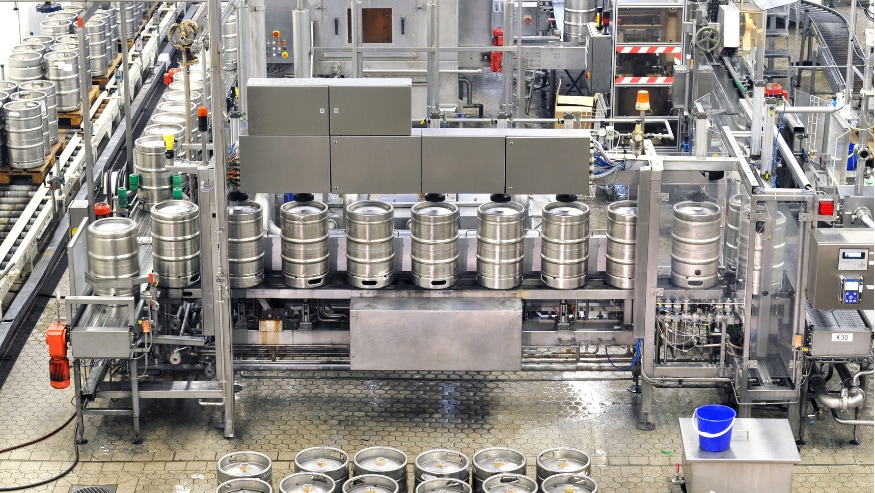The Challenges of Managing a Brewery Sustainably

Running a brewery has never been easy. But today, on top of the core challenges of producing consistent, high-quality beer, brewers are prioritizing sustainable brewing practices that add new twists to every aspect of brewing operations.
We’ve already seen the world’s major brewers make commendable strides on the sustainability front — using less water and energy in the production process each year. The last decade saw the brewing industry decrease the average amount of energy used per liter of beer produced by nearly 20%. Over the same period, the brewing industry lowered the amount of water used by a full 25%, from an average of 4 liters of water per liter of beer in 2011 to 3 liters in 2020.
Yet, given growing concerns — increasing water stress, looming impacts of climate change, sporadic energy shortages, etc. — many leading brewers are further intensifying their sustainability efforts. For example, some major brewers are now targeting plans to reach an average of 2 liters of water per liter of beer by 2030 or earlier.
These sustainability improvements cannot be pursued in a vacuum. The reality is sustainable brewing practices are woven into an intricate web of six essential objectives of every brewery:
- Produce great beer
- Minimize food safety risks
- Reduce water and energy
- Protect assets
- Maintain wastewater compliance
- Minimize costs
Each of these objectives is challenging on its own. But each discrete objective also presents multiple interdependencies that impact the others. In many instances, improving one can negatively impact others. And to further complicate matters, each objective typically falls under the responsibility of a different person, so the goals of managers often clash.
Let’s take a closer look.
“The majority of water utilized in the brewing process does not end up in the barrel; it goes to the waste stream.”
Chris Armacost
Director of Marketing, Food & Beverage Global Solutions at Ecolab
1. Produce Great Beer
(Brewing Manager / Packaging Manager)
Most breweries’ essential goal is to produce as much beer as possible, given their production assets. But quantity can’t come at the expense of quality. To stay in business, a brewery needs to produce high-quality beer with a consistent taste. That, in turn, requires a strong quality program to ensure that critical equipment is thoroughly cleaned and sanitized before each production run to prevent off-flavors and beer spoilers. And a thorough cleaning regimen requires production lines to be shut down, eating into beer production capacity.
This sets up one of the most fundamental balances every brewer must manage: the tension between production uptime and cleaning downtime, to maximize production volume without compromising product quality.
2. Minimize Food Safety Risks
(Quality Manager/Sanitarian)
In between batches, brewers must clean and sanitize critical equipment like brew kettles, fermenters, bright beer tanks, and fillers to eliminate soils and beer spoilers and minimize any risk to consumers. There is no one-size-fits-all food safety and quality program. Programs can differ, depending on the type of beverage produced, the toughness and character of the soils, and the quality of the water in use at the brewery. Some cleaning regimens require more steps and therefore take more time. Some are run at hotter temperatures and therefore use more energy and may impair asset life. Others have longer rinse requirements and hence use more water. Certain advanced chemistries allow faster cleaning with lower use of water and energy, but come at a higher cost. These factors — the type and frequency of cleaning — can have significant impact on wastewater discharge.
As you can see, quality programs touch virtually every one of the six objectives in some manner or other. Brewers must manage these many trade-offs when determining the optimal cleaning and sanitizing program.
3. Reduce Water and Energy
(Sustainability Manager)
Water and energy are essential to the brewing process, but they are also costs; hence, a brewery must optimize their use. As mentioned at the outset, in our climate-challenged, water-stressed world, there are also political, cultural, and existential reasons to use as little water and energy as possible. At least one major brand has been forced to move an existing brewery several hundred miles away because its location no longer had sufficient water to continue making beer.
There is, of course, a baseline amount of water and energy needed in the beer-making process. Beyond that, there are choices a brewery makes that either increase or decrease the amounts needed. For example, the choice of cleaning program — whether hot or cold —impacts the amount of water and energy required. The efficiency with which boilers, cooling systems, and pasteurizers are managed impacts water and energy usage. Poorly managed systems develop scale, corrosion, or microbiological fouling — all of which contribute to a greater need for water and energy to get the same result as well-managed systems.
There are also ways to reduce water and energy by re-using it elsewhere in the brewery. Some locations are experimenting with polishing, filtering, and recycling wastewater and returning it to the brewery in an endless cycle called “zero liquid discharge.” Biogas energy from wastewater systems can be captured and re-used elsewhere. These circular solutions can significantly lower water and energy usage, but the engineering and capital involved can materially increase costs.
4. Protect Assets
(Engineering Manager)
Brewery equipment is not cheap. A central tenet of effective operations focuses on protecting those expensive assets—taking strategic steps to lengthen their useful life and avoid the cost of premature replacement. A variety of factors impact an asset’s lifespan, including scale buildup, corrosion, use of the wrong cleaning solutions, high temperatures, infrequent cleaning, lack of maintenance, or over-usage. Traditionally, the remedy for most of these challenges involves non-production downtime. Brewers typically want long production runs, but long runs translate to shorter downtime windows for both cleaning and maintenance.
This again requires a delicate balance. Practices and protocols that may increase production volume and efficiency may simultaneously reduce time for maintenance, leading to costly repairs or early replacement of assets. Likewise, brewers may aim to reduce water and energy usage through changes in production and cleaning protocols, but they must be aware of how changes may impact equipment performance and lifespan.
5. Maintain Wastewater Compliance
(Environmental Manager)
The majority of water utilized in the brewing process does not end up in the barrel; it goes to the waste stream. Many things go down the drain and end up in the wastewater area: discarded batches of low-quality beer, excess cleaning solution, lubricants from cleaned conveyors, and a myriad of other possibilities. Breweries must manage all of this carefully to protect their brand reputation and minimize costs. They must also avoid the worst case: when the wastewater system gets backed up to the point that production must be shut down.
Some brewers fully process their wastewater themselves and discharge the “polished” effluent back into a nearby lake or river. Others treat the wastewater more minimally and relay it to their municipal wastewater plant for full processing. In both cases, the effluent water must stay within strict boundaries set by the municipality. Otherwise, the brewery faces fines (increased cost).
To compound matters, as a brewery reduces the amount of water it uses, the percentage of contaminants remaining in the wastewater automatically increases. For example, a wastewater stream with 100ppm of contaminants suddenly will have 200ppm of contaminants if the brewery cuts that water stream by 50%. Since discharge permits are generally based on ppm ranges of contaminants, saving water makes wastewater compliance more difficult.
6. Minimize Costs
(Plant Manager + Dept Heads)
Finally, as with any profit-seeking venture, the underlying objective of a responsible brewer is to produce excellent beer at the lowest possible cost. The beer recipe itself has its cost structure, but each of the factors discussed above play into the brewer’s total costs, including the amount of water and energy used, capital employed for water or energy re-use or recycling, choice of cleaning and sanitizing solutions, the efficiency with which utilities and other assets are managed, and the competence with which wastewater is discharged.
Without an effective balance in cost optimization, a brewery’s success is time-limited: Its bottom line needs to be healthy, or its days are numbered.
Beer is Simple — Brewing is a Balancing Act
The process of running a brewery is highly complex — and layering in increasingly critical sustainability considerations significantly amplifies that complexity. Each of the six main objectives is difficult to manage on its own. The interdependencies among them further complicate matters. And the divided responsibilities only pit the various managers’ performances against each other. For example, a new five-star quality program may lead to a big bonus for the Quality Manager, but if it requires more water or production downtime than anticipated, the Sustainability Manager and Production Manager may miss out on theirs.
Done well, this is a great balancing act. Done poorly, it is an endless game of whack-a-mole.
Brewers today should be lauded for managing this balancing act — and, in particular, for their progress in reducing water and energy, all without impacting their commitment to outstanding quality.
So, while beer is a simple product — with only four “official” ingredients: water, barley, yeast, and hops — in today’s competitive environment, operating a brewery is anything but simple. Think about that the next time you pop open a cold one.
Connect with an Ecolab Brewing Expert
Talk with an Ecolab expert about aligning your brewing goals — from quality and efficiency to hygiene and water management.
Learn more about Ecolab brewery solutions.


